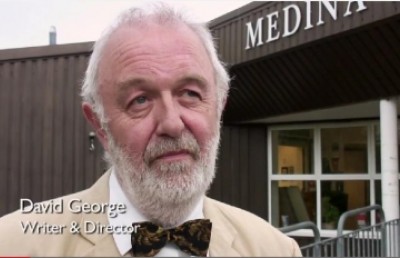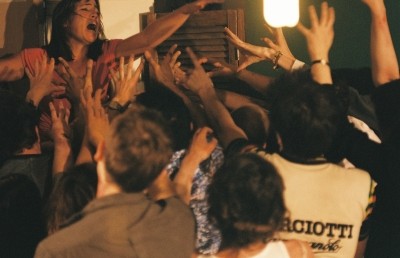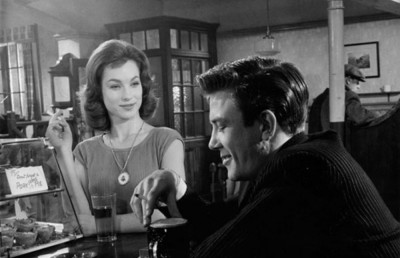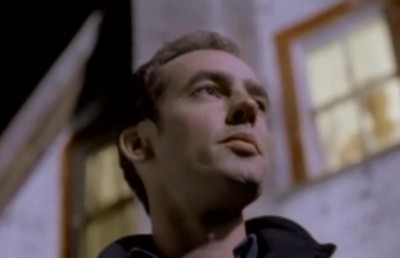Yesterday: Rob Grant Interview
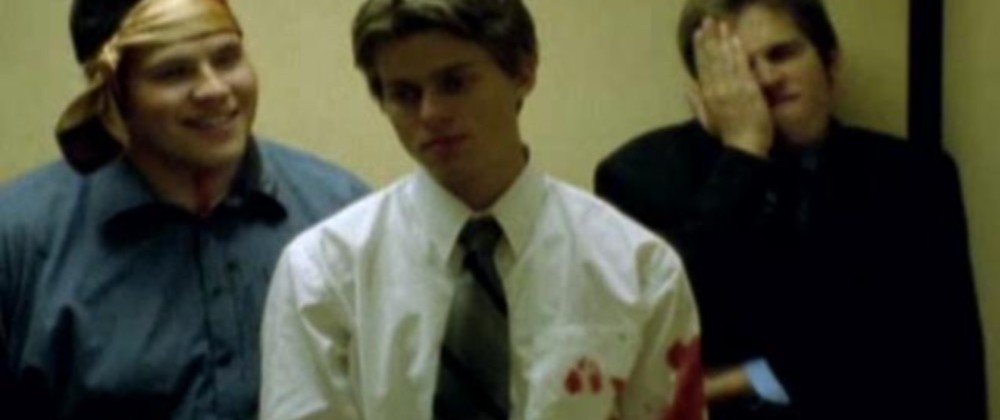
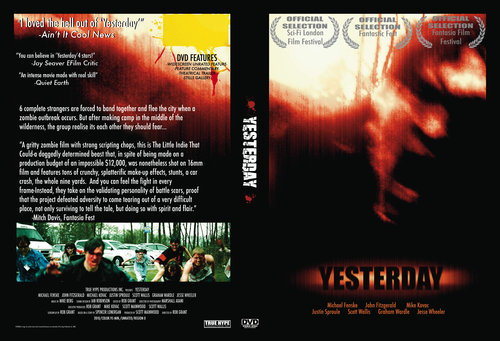
Yesterday 2010, Canada
Writer/Director: Rob Grant
CAST: Dave (Mike Fenske); Graham (Jesse Wheeler); Rob (Justin Sproule), Lewis (Scott Wallis); Mike (Mike Kovac); Chris (Graham ardle), Eric (Rob Grant); Spencer (Zia Marashi); Doug (Len Harvey), Andrew (John Fitzgerald)
CREDITS:
Directed by Rob Grant
Produced by Scott Mainwood
Edited by Rob Grant
Director of Photography by Marshall Axani
Music: Mike Berg
The Canadian zombie film Yesterday played to an enthusiastic audience at the 2009 Fantasia International Film Festival. Audiences at Fantasia (and other genre festivals) are usually more forgiving for the shortcomings that may come with miniscule budgeted films (rough visual look, limited locations, practical production values, passable acting). In some cases the limitations can work for the film in that the audience overcompensates by greatly appreciating the contrasting traits and qualities that can come precisely as a byproduct of miniscule budgets (idiosyncratic visual style, small scale over large scale drama, quirky and personal stories, downbeat ending, etc.). Yesterday fits the latter to the tea by taking a standard zombie scenario (strangers forced to band together to stave off a rampant zombie population) and injecting it with youthful energy and touches of emotional depth (aided by an excellent original music score by Mike Berg). A group of disconnected characters learn the hard way that people around them are turning violent and very hungry (for human flesh). Circumstances bring the disparate group of people together, and the interpersonal dynamics among the group proves to be more of a danger to their personal safety than the ‘enemy’. The following interview with writer and producer Rob Grant was conducted by email in late September 2011.
Offscreen: Let’s start with some general questions on the production of the film. First off, what is your background? How did you get involved in filmmaking?
Rob Grant: I was always filming little scenes here and there growing up on my Dad’s video camera, then would create snowboarding and skateboarding videos for my friends in high school. That’s where I learned to love editing. Sitting in front of a computer with your footage already shot you are forced to make puzzle pieces fit, that’s the exciting part for me. I attended the Capilano Film Program for a year out of high school then transferred to the University of British Columbia. I applied to the Film Program there but joked to my cousin that if I didn’t get in I would use my tuition money to make a feature, I was then promptly denied to the Program and that summer we shot a feature which went on to become Yesterday. After the movie we all went back to school where I graduated from UBC with a Philosophy degree and now work as an Assistant Editor.
Offscreen: I won’t ask about budget because I normally don’t care and it is pretty obvious the film was low budget (this info is on the official site anyway). But how long was the shoot? What kind of sequence was the shooting done in (based on logistics of locations, linear to narrative)?
RG: We were all pretty green aside from the short films we had made in the Capilano Film Program so we had a basis for shooting a feature but I think we were all a little naive about the process. I mean realistically, writing a zombie feature with multiple locations and multiple main characters on no budget was completely insane. But no one told us we couldn’t do it, so we just kept on going. We shot for 30 days over August 2006, and were literally running from location to location. We mainly shot in order but would shoot out locations so we wouldn’t have to come back when necessary.
Offscreen: I love that it was shot on 16mm. In this day of small budget films shooting digital, why did you stick to film? What kind of camera did you use to film it?
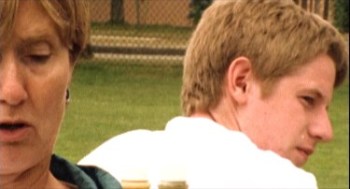
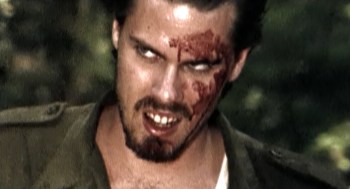
16mm grain and grit
RG: We shot on film for a couple reasons. The first was what was available at the time. In 2006 digital technology just wasn’t where it is now, I didn’t like the look of what was coming out of those cameras and to me, a zombie movie is heavily based on aesthetic. When I think of a zombie film I think of old Romero style films that are gritty and nostalgic. There is a scene after the credits that we shot unscripted as a joke on the day with a DVX from behind the scenes, and even from watching that I just don’t think the movie would feel right if the entire feature was shot on that. Another reason was that I was working at a post house as the time which meant I had access to their film processing abilities and so to be able to develop, transfer, and color time film for free was a huge opportunity to take. We mainly shot with a refurbished Eclair ACL 2…but when a faulty tripod dropped the camera we were forced to start using a Russian hand-crank camera for a little while…then a CP-16 until its take up broke…then another CP-16 broke…then finally we got our hands on another Eclair. The camera gods didn’t want this movie to get finished….haha.
Offscreen: Ok, let’s get to the good stuff! I really love the fact that it is a zombie film but that word is never mentioned. Which raises the question: is it a zombie film if the crisis or threat is never cited as such!
RG: Hmmm, good question. I definitely would call it a zombie film myself, but maybe a few more people needed to be killed by zombies rather than each other!
Offscreen: Come to think of it, it has been a long time since I’ve seen it, but I don’t think they say the word ‘zombie’ in Night of the Living Dead either?
RG: I think you’re right. I’m not sure what Romero’s logic behind that decision was, but I was just trying to make a zombie movie for people that don’t like zombie movies so I figured not using the term would help.
Offscreen: I also like the way you achieve a nice sense of isolation. It seems we never see any other characters other than the principals (except for the woman at the beginning trying to enter the bar and maybe one or two others) and the zombies. How was this achieved? Did you shoot at odd times of the day? Was it all in the framing?
RG: That was a combination of luck and location. Since we had no money, we couldn’t afford permits, and so any exterior location had to be stolen. Knowing this, we intentionally picked isolated locations so we wouldn’t get noticed. Shooting in the suburbs where there are less people certainly helped. The liquor store would have been our busiest exterior but it was shot at 6am so we only had to worry about two drunk people fighting over a cab ride home in the parking lot!
Offscreen: Mentioning Romero, it is pretty much impossible for any zombie film not to bear some influence of the master, but in your film the references are all in snippets of dialogue, location moments (like the roof scene), the slow movement of the zombies, the ordinary behavior of some zombies, etc. How would you describe the influence of Romero on your film? Dawn of the Dead seems the film most referenced. Do you have a favorite Romero film?
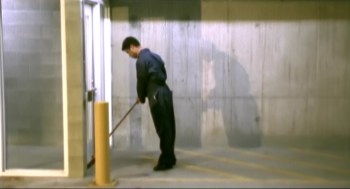
Zombie janitor invokes Dawn of the Dead
RG: Dawn of the Dead is definitely my favourite, so good call on the references. Who wouldn’t want a shopping mall to themselves? I’d say the slow moving zombies is probably his biggest influence on me. Romero had it figured out for sure. There is something far more scary to me about this slow moving force coming for you rather than a corpse that could run the hundred meter dash.
Offscreen: What are some of your favorite non-Romero zombie films?
RG: I think we all owe Danny Boyle a thank you. 28 Days Later, while I wouldn’t call it a zombie movie, it did start the zombie revolution we had recently. I also loved Zack Snyder’s remake of Dawn of the Dead, Shaun of the Dead, and most recently Zombieland was badass. It seems the new trend for zombie movies is to be self-aware which is just opening the door for more comedy in zombie films.
Offscreen: Having noted this influence, I would also say that your film is greatly influenced by more contemporary trends in popular film, like the network or cross-over narrative, where different sets of characters are introduced through editing in their own spaces, until they eventually join up. And I think the amount of gun play (not to mention gun posturing, but that’s another question) is influenced by contemporary action films. Would you say that is a fair assessment of where your film fits in terms of contemporary genre?
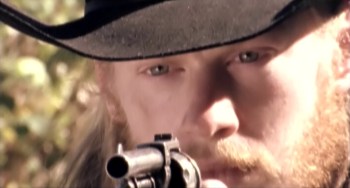
Western-hero modeled Mike takes aim
RG: Totally fair assessment! It sounds silly now, but while I was writing the film one of the biggest influences was Paul Haggis’ Crash. I’d never seen a zombie film formatted in that style and I thought it would be a great way to try and avoid the classic cliche of a group of survivors boarding up a house and waiting for the zombies to find them. I really wanted the movie to be a zombie film disguised as something else….something more contemporary.
Offscreen: In terms of the guns, this also bears the influence of the western on Yesterday, most specifically the Leone spaghetti western (actually cited in the text by Mike, who brings his father a ‘Leone” western). I like the paraphrasing of the Morricone score in the final showdown. Yes it is pretty slavish but you are never trying to hide this fact. It comes across as a loving homage. And I think Leone’s work is some of the greatest cinema to come out of the popular vein. Why did you reference him so directly?
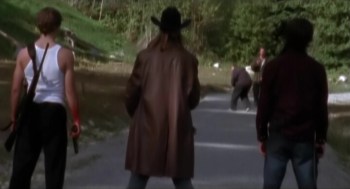
Leone inspired 3-shot
RG: I’m a huge western fan, Once Upon A Time in the West being one of my favourite movies hands down. I definitely wanted there to be a western feel. I always thought the zombie genre had so many similarities to westerns. It just made sense to me that in the event of society breaking down we’d go back to a ‘wild west’ style of lawlessness until order was restored, that there is always the threat of violence breaking out at any time.
Offscreen: I think the guns are also used as a sign of character judgment, of character morality. How a person uses the gun, and by extension violence, reflects their moral code, again right out of the western. But the way the characters posture and flay about their guns so much suggests maybe a tiny critique of such male posturing on your part. And maybe even an over-the-top sexual reference (men playing with their ‘toys’). What was the thought behind using the gun so much in the film?
RG: I think what I was aiming for was the reality of gun knowledge or lack there of by average people. If you dropped a gun in the hands of someone who has never used one before and didn’t teach them how to use them properly and safely they would just go with what they saw in movies, which is of course totally wrong and unsafe. My uncle taught me how to shoot and use guns properly and once he did I just thought about how easy it is to misuse and abuse them and its all due to how you see people handle them in films. I just wanted to make sure that any characters in the film that were inexperienced with guns would use them wrong, and give them a sense of bravado that definitely comes with holding something so dangerous.
Offscreen: Once the zombie crisis is established they seep into the background and the film becomes more about the inner personal dynamics among the characters. How much time did you spend thinking about and crafting the specific character types? Where do they come from?
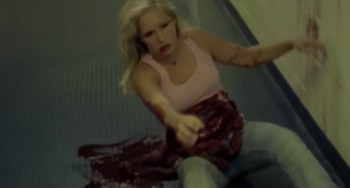
Do blonde-haired zombies have more fun?
RG: I was 19 when first started thinking about the story and 21 when we shot it so I was pretty inexperienced and immature with crafting proper storytelling. A lot of what came out was just what I thought made the story interesting. I remember thinking what kinds of people would be interesting to lock up together? Who would clash the most? I figured that the movie would be far more stale if characters were more similar than not so I basically just picked all these well known archetypical figures and tried to write ways they could end up colliding with each other.
Offscreen: It seems your film plays pretty much by the classic zombie rules and conventions (shooting in the head, slow moving, minimal sense of their own identity, eating flesh, etc.). Were you ever tempted to throw a curveball and alter the playing field a bit, or did you just want to stick to the classical?
RG: I always wanted to stick to the rules Romero laid out. This was a sort of ‘thank you’ letter to him as his movies were what I grew up on and got me interested in special effects and movie making in general. I think we were all young as well and too nervous to try and change the rules.
Offscreen: One way your film is not like Romero’s is that all your central characters are men, whereas Romero always has strong female characters. My guess is the reason stems from some of the previous things I’ve asked you about, but just wanted to hear your thoughts on the (almost) all-male casting?
RG: The male cast just grew out of writing what I knew I had available. What I had were a bunch of male friends and acquaintances that all loved zombie movies and wanted to act. I just didn’t know a ton of female actors at the time. That being said though, I still think even if I had an abundance of female talent, I’d still lean towards the male side of the story. I don’t think I’m a talented writer enough to grasp the female perspective I think…
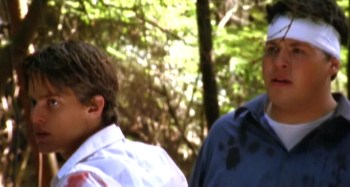
Dave and Graham
Offscreen: Was it just a coincidence or was the scene where Mike hears his father being attacked over the phone, yelling at his father “don’t open the door, don’t open the door…” an homage to Fulci’s Zombie, where (if memory serves me right) a similar attack is heard over the phone?
RG: Uh oh, if it was then it was subconsciously! I haven’t watched Zombie in years, going to have to watch it again obviously now.
Offscreen: All in all I think the performances are good. My only reservation is with the casting of Dave, Spencer and Graham for the jobs their characters assume, businessmen. They just struck me as being too young for their jobs, but that sort of casting problem exists in a lot of low budget films where young filmmakers are drawing on their friends for casting. More an observation than a comment.
RG: Totally agree. I mean looking back we were awfully brash trying to make a feature at 21. I watch it now and there is a ton I’d do differently, but that being said I’m very proud of what we were able to accomplish at the time with very little resources.
Offscreen: I like the way you undercut the Chris’ romantic/idealized death by cutting back to them as zombies who continue their male posturing and bickering. Also wondering about the surprise post-credit flashback scene that ironically shows the baddies Rob and Lewis were telling the truth about Graham. Is this scene also in the final version of the film (DVD or theatrical)?
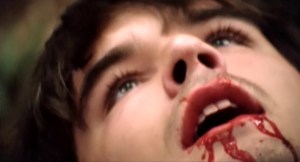
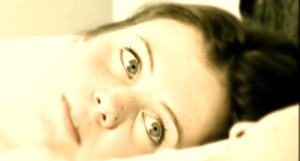
Chris’ dying fantasy of fiancee Sarah
RG: Yes the scene made it on the DVD release. That was really more of us just having a little fun with the audience!
Offscreen: In terms of the actual location of the story, I don’t think any city is ever mentioned, although people from Vancouver will recognize the locations. Were you consciously trying to avoid placing it in any specific city for release purposes? (Although the references to hockey will surely be a good hint that it is from Canada!)
RG: Yeah, I love when movies don’t name where it is. I tried to keep the location ambiguous because I feel the audience can decide where they want it to be, or relate it to their areas. And I referenced the Philadelphia Flyers as another nod to Romero and reference to Pennsylvania where Night of the Living Dead was shot.
Offscreen: Any unusual production stories you can relate about the shoot?
RG: The highlight was the car crash where Chris’ fiance died. We of course didn’t have enough money for a stunt man, so I suited up in hockey gear and crashed the cars myself. I was hoping to inspire the cast and crew who were donating all their time for free, but I think they just thought I was nuts. Having our camera fall off the tripod on shoot Day 13 was probably the worst moment, followed by the other cameras breaking down. But hey what’s a movie without a little hardship right?
Offscreen: I know the film played at Fantasia in 2009. Where else has the film played? How has it been received?
RG: All in all the film played at: Canada International Film Festival, Magnolia, Macon, Sci-Fi Athens, Okanagan, Sci-Fi London, Seattle True Indi Fest, deadCenter, Montevideo, SP Terror, Fantastic Fest, Buenos Aires Blood Red Film Fest, Revenant Film Fest, and Workhouse Festival all in 2009. It seems to be received fairly positive, it still surprises me that what was a summer project out of boredom and contempt kind of blossomed into this film. It definitely has its flaws but people seem to ignore them for some reason which is always nice!
Offscreen: Any new projects on the horizon?
RG: We just had our first test screening (something we didn’t do on Yesterday) for our second feature entitled Mon Ami which is a horror film disguised as a buddy comedy. It’s about two friends who kidnap their bosses daughter and hold her for ransom. I’m really glad I got the opportunity to shoot another feature. I really think I’ve matured as a film maker and really wanted to show that I’ve learned from my mistakes that I learned making Yesterday, so hopefully people enjoy this one a lot. We did switch to digital as well, I no longer get cheap transferring of film so we had to give in.
Offscreen: Thanks Rob!
RG: Thanks for the kind words, the interest, and the hard work. This little movie wouldn’t have gotten one tenth of the recognition it has without people like you, so thank you very much.
To purchase the DVD visit the: Official Site
View trailer.



